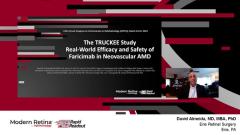
Study Design and Preliminary Results From the TRUCKEE Study Evaluating Faricimab in Real-World Neovascular AMD Patients
David Almeida, MD, MBA, PhD, reviews the objectives and design of the TRUCKEE study, and discusses the visual and anatomic outcomes after one and three injections of faricimab in neovascular AMD.
Episodes in this series
David Almeida, MD, PhD, MBA: My name is Dr David Almeida. I’m a retina specialist and the director of clinical research at Erie Retinal Surgery in Erie, Pennsylvania. I had the pleasure of being at the Congress on Controversies in Ophthalmology [COPHy] in Lisbon, Portugal, at the end of March, where I presented my poster on the TRUCKEE study, a real-world efficacy and safety of faricimab and neovascular age-related macular degeneration. Age-related macular degeneration is the No. 1 cause of blindness in patients over 65, so it was a logical starting point. The drive and impetus for TRUCKEE was the idea that medications like faricimab, which is a biphasic compound, can address both VEGF-A and Ang2 as targets. Biphasic compounds in the real world don’t always get used the way clinical trials are modeled out. That means that real-world patients tend not to be treatment naïve or. A large part, especially at the beginning, tend to be recalcitrant patients with multiple treatment regimens in the past. This is where TRUCKEE comes in, because it’s essentially a real-world prospective study that evaluates the safety and efficacy of faricimab. But it’s going to take all comers, essentially treatment-naïve patients, patients who are switched from another medicine, and patients who have been on multiple medicines and are switched and moved to intravitreal faricimab.
We had over 500 patients in TRUCKEE. The main outcome measure that we were looking at is best-corrected visual acuity, which is ultimately what the patient cares about the most. Anatomical outcomes like central subfield thickness, degree of pigment epithelial detachment, or choroidal neovascular membrane. We looked at durability: how long do the patients go after these injections? We also looked at safety: are there any new safety signals that we need to worry about? When we move to the results of TRUCKEE, we look at a well-balanced population of over 500 patients. The group could be defined in large silos. Do these patients have previous treatment? This is the largest group, 90% of patients in TRUCKEE. Of that group, aflibercept was over 50% of patients who were switched from aflibercept to faricimab. There was also ranibizumab, which is about 10%. Brolucizumab and bevacizumab, were less than 10%. Treatment-naïve patients in TRUCKEE were about 10%, which is a much smaller portion compared with the registry trials but still represented in the TRUCKEE sample.
We’re going to look at 2 scenarios in TRUCKEE. One, what happens when you have a patient who has 1 injection? A lot of retina specialists, a lot of investigators, are going to use that medicine that’s been approved, but they may not necessarily sign up for multiple dose regimens or continuous use of that medication. They may use 1 injection and then assess what the response is like. Then they’ll use something similar to what longer-term use is going to model, which is multiple injections, namely 3 in the TRUCKEE study. When we look at patients, including patients who bad disease previously and were switched over to faricimab after 1 injection, we see an improvement of about 1.1 letters, with a nice improvement of over 30 μm on the central subfield thickness OCT [optical coherence tomography]. That therapeutic effect is augmented after 3 injections, when we see a further improvement up to 3.2 letters in their best-corrected visual acuity and a further decrease or improvement in their central subfield thickness of almost 50 μm on their OCT.
When we take the results further, we’re seeing that no matter where that patient is coming from, if that patient is treatment naïve, if that patient was on aflibercept, ranibizumab, or another agent, their anatomy is going to improve, so their central subfield thickness is going to go down. They’re going to have better anatomy in their outer and inner retina, and their vision is going to improve as well…. When we’re trying to model a real-world study, those are the things that come up over and over because we’re dominated by what the patients experience—that’s their vision—and we’re reliably using a metric, which tends to be OCT-based biomarkers during the treatment.
I presented a case example on the poster from TRUCKEE, which involved a patient who shows nice improvement in subretinal fluid after switching. Vision improved from 20/40 to 20/30. One faricimab subretinal fluid that had previously been recalcitrant and unable to be resolved had a nice improvement. Intraretinal fluid, which is traditionally considered more dangerous in neovascular age-related macular degeneration or associated with more negative prognostic outcomes in these patients with neovascular disease, also showed an improvement. It went from 20/50 to 20/40, with a nice improvement in their intraretinal fluid, which was extensive on previous treatment but improved after faricimab.
Safety is an important part of any real-world study, and TRUCKEE is no different. We know that from previous medications and early phase programs, irrespective of what discipline it is, that you may see safety signals that you may not have been prepared for. The safety analysis in TRUCKEE with faricimab was looking at those 2 aspects: are there any new safety signals that we weren’t aware of that need to be considered? Or were there any severe material safety signals that need to be considered when you’re treating or dosing or patients with faricimab? What we see in TRUCKEE is that after 1231 injections in 550 eyes, we had 2 cases that were notable. First, a case of infectious endophthalmitis, where the vision returned to baseline after 3 weeks. Second, a mild intraocular inflammation reaction that was seen after a fourth faricimab injection, which returned to normal with topical corticosteroids. There were no cases of occlusive vasculitis, retinal vasculitis, or retinal artery occlusion observed in TRUCKEE. This is important because that’s a new signal that we had seen from the brolucizumab use in the real world. This was 1 of the main tenets that TRUCKEE was trying to identify, and we did not see any, which was very reassuring.
In conclusion, we see that faricimab demonstrates improvement and maintenance of both visual acuity and the anatomical outcomes, which become critical in managing patients with neovascular age-related macular degeneration. With good safety, there was no incidence of intraocular inflammation with any severe vision loss. It was well tolerated, and patients were able to be extended further than they had previously been with their single monotherapy agent. Now faricimab has a biphasic agent that can decrease that treatment burden with good vision improvement.
What clinical implications are we going to take from faricimab? What are we going to take from TRUCKEE? First, as we discussed at COPHy, as more countries get their approval, it’s going to be this ability to have good outcomes. Regardless of whether it’s a treatment-naïve patient or a patient who has been previously stuck on or unable to extend on a previous agent, we see good tolerability in these patients. Second, there are good safety signals, with no new worrisome safety signals, in the TRUCKEE population. We’ll continue to assess as we correspond and compare the clinical trial registry results.
Transcript edited for clarity
Newsletter
Get the essential updates shaping the future of pharma manufacturing and compliance—subscribe today to Pharmaceutical Technology and never miss a breakthrough.















































